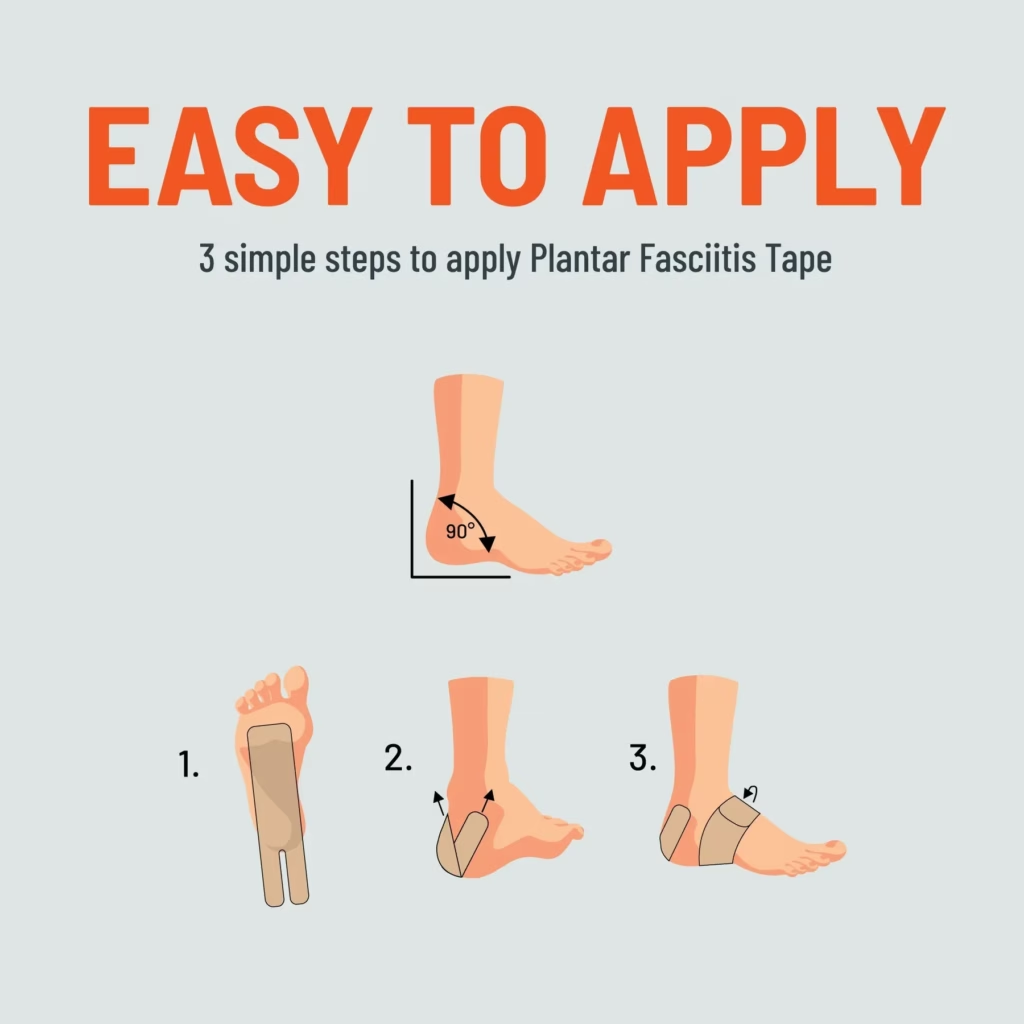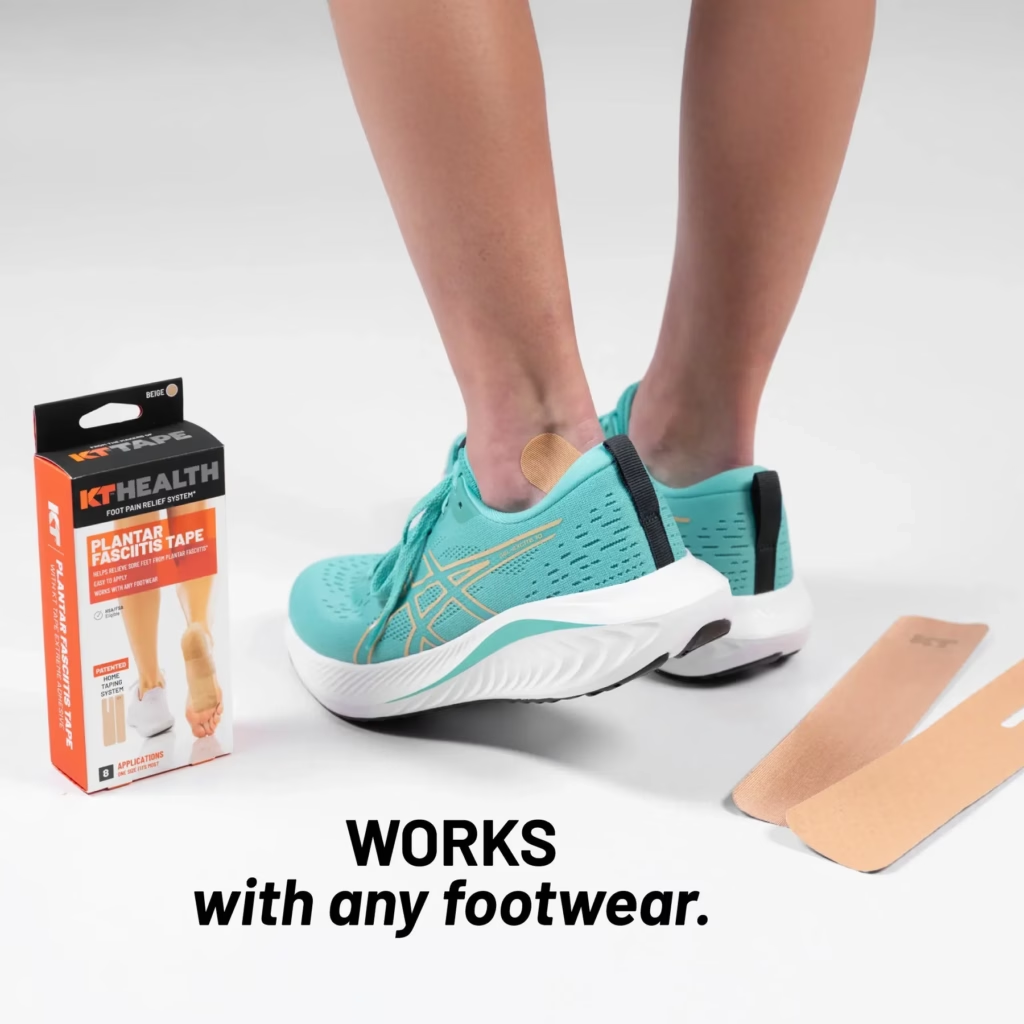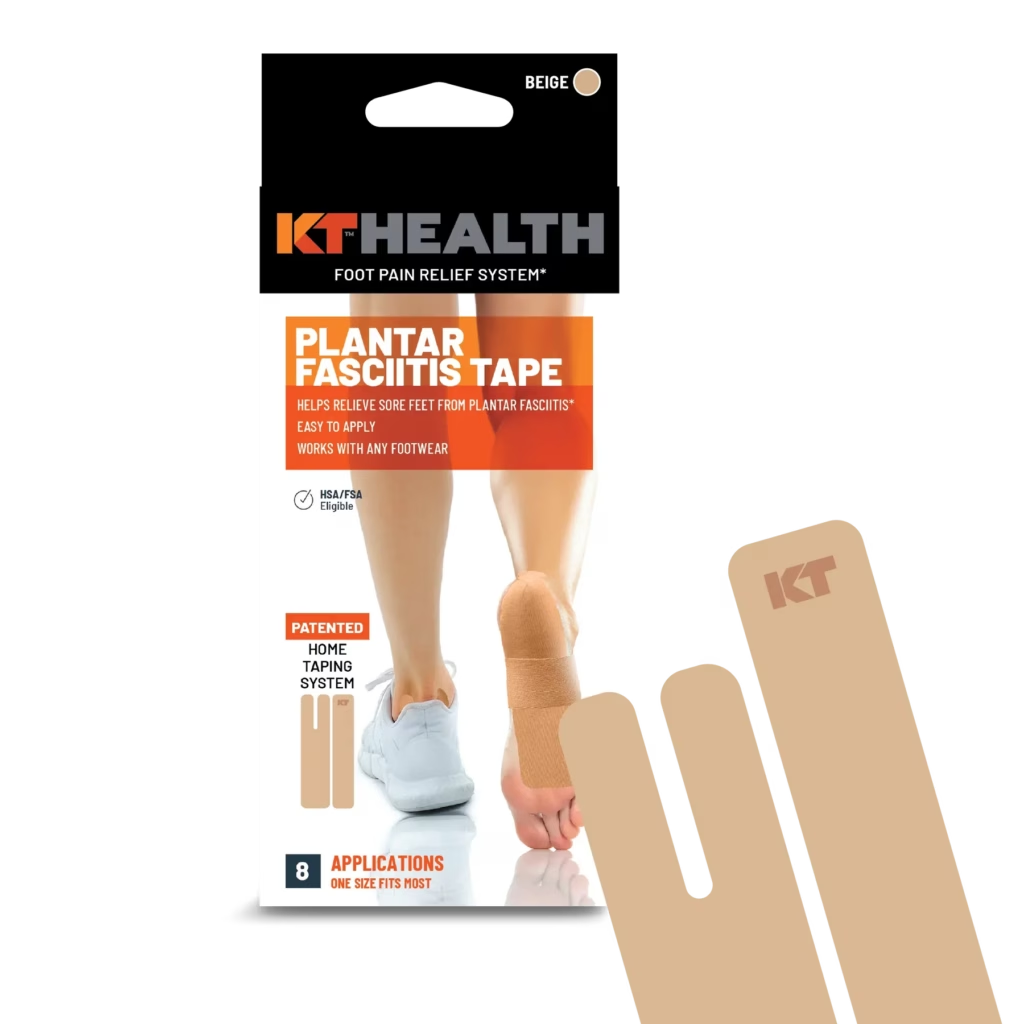Plantar fasciitis, a common cause of heel pain, affects many individuals, especially those engaged in high-impact activities like CrossFit. The discomfort can hinder performance and daily life. Fortunately, KT Tape has developed a specialized KT Tape Plantar Fasciitis Tape designed to alleviate this pain and support your active lifestyle, allowing you to stay active and pain-free.
Table of Contents
For those dealing with plantar fasciitis, KT Tape Plantar Fasciitis Tape is an effective tool that many athletes and active individuals have found beneficial. This comprehensive guide will cover how to use KT Tape Plantar Fasciitis Tape effectively.
Many athletes have turned to KT Tape Plantar Fasciitis Tape for its remarkable benefits in managing heel pain.
Understanding Plantar Fasciitis

The Role of KT Tape Plantar Fasciitis Tape in Pain Management
KT Tape Plantar Fasciitis Tape is particularly effective for those participating in strenuous activities.
Utilizing KT Tape Plantar Fasciitis Tape can lead to improved mobility and comfort.
Integrating KT Tape Plantar Fasciitis Tape into your routine can significantly enhance your athletic performance.
Experts recommend KT Tape Plantar Fasciitis Tape for athletes facing ongoing foot challenges.
Many users have experienced the benefits of KT Tape Plantar Fasciitis Tape, reporting significant pain relief.
Additionally, KT Tape Plantar Fasciitis Tape can be used in conjunction with other treatments for comprehensive relief.
Using KT Tape Plantar Fasciitis Tape can significantly improve your comfort and performance levels, making it a must-have for anyone struggling with heel pain.
Many users find that KT Tape Plantar Fasciitis Tape not only alleviates pain but also offers support during high-impact workouts, making it essential for athletes.
In summary, KT Tape Plantar Fasciitis Tape is designed not just for pain relief but to enhance your overall performance while participating in sports.
Plantar fasciitis involves inflammation of the plantar fascia, the thick band of tissue connecting the heel bone to the toes.This condition often results in stabbing pain near the heel, particularly with the first steps in the morning or after prolonged periods of rest. Factors contributing to plantar fasciitis include overuse, improper footwear, and excessive standing or running. Wikipedia+1Mayo Clinic+1
KT Tape’s Plantar Fasciitis Tape offers targeted relief for those suffering from plantar fasciitis. This innovative product provides support to the arch and heel, reducing pain and promoting healing. It’s designed for easy application and can be worn with any footwear, making it ideal for athletes and individuals on the go.
Key Features and Benefits
- Targeted Pain Relief: The tape supports the plantar fascia, alleviating discomfort associated with plantar fasciitis.
- Easy Application: KT Tape’s patented design ensures a straightforward application process, suitable for personal use without professional assistance.KT Tape
- Versatile Use: Compatible with various footwear, the tape can be worn during workouts, daily activities, or even at night.
- Durable and Comfortable: Crafted from high-quality materials, the tape offers durability while maintaining comfort during extended wear.
How to Apply KT Tape for Plantar Fasciitis
Proper application is crucial for optimal results. KT Tape provides comprehensive instructions and video tutorials to guide users through the process. By following these guidelines, you can ensure the tape provides maximum support and relief.KT Tape
Integrating KT Tape into Your Fitness Routine
At CrossFit Angier, we understand the importance of maintaining peak physical condition. Incorporating KT Tape’s Plantar Fasciitis Tape into your regimen can help manage foot pain, allowing you to focus on achieving your fitness goals without discomfort.
Customer Testimonials
Many users have experienced significant relief from plantar fasciitis pain after using KT Tape. Athletes and fitness enthusiasts alike praise its effectiveness and ease of use, noting improvements in both comfort and performance.
Understanding Plantar Fasciitis: Causes, Symptoms, and Effective Management
Plantar fasciitis is a prevalent condition that affects a significant portion of the population, particularly those engaged in high-impact activities like CrossFit. This article delves into the intricacies of plantar fasciitis, exploring its causes, symptoms, and various management strategies to help individuals maintain an active lifestyle without discomfort.
Epidemiology and Prevalence
Plantar fasciitis is the most common cause of heel pain presenting in the outpatient setting, affecting approximately 4% to 7% of the community. The condition accounts for about 15% of foot injuries in the general population, with the highest incidence occurring among individuals aged 40 to 60 years. In the United States, plantar fasciitis affects 10% of the population, leading to over one million physician visits annually. PhysiopediaBioMed Central
Anatomy and Pathophysiology
The plantar fascia is a thick, fibrous band of connective tissue that originates from the medial tubercle of the calcaneus (heel bone) and extends along the bottom of the foot, inserting into the bases of the toes. Its primary function is to support the arch of the foot and absorb shock during activities such as walking, running, and jumping. When excessive stress is placed on the plantar fascia, microtears can occur, leading to inflammation and pain—a condition known as plantar fasciitis.
Risk Factors

Several factors can increase the likelihood of developing plantar fasciitis:
- Age: Individuals between 40 and 60 years old are at higher risk.Physiopedia+1PMC+1
- Physical Activity: Engaging in high-impact exercises, such as running or CrossFit, can place additional stress on the plantar fascia.
- Foot Mechanics: Flat feet, high arches, or abnormal walking patterns can affect weight distribution, increasing strain on the plantar fascia.GQ
- Obesity: Excess body weight adds extra pressure on the plantar fascia.
- Occupational Hazards: Jobs that require prolonged standing or walking on hard surfaces can contribute to the development of plantar fasciitis. Cleveland Clinic
Symptoms
The hallmark symptom of plantar fasciitis is a sharp, stabbing pain in the bottom of the foot near the heel. This pain is typically most severe with the first steps in the morning or after periods of inactivity. As the foot warms up, the pain may decrease but can return after long periods of standing or after exercise. Cleveland Clinic
Diagnosis
Diagnosing plantar fasciitis primarily involves a clinical evaluation. A healthcare provider will assess the patient’s medical history and perform a physical examination, checking for areas of tenderness and evaluating foot mechanics. Imaging studies, such as X-rays or MRIs, are typically reserved for cases where a fracture or other pathology is suspected.
Conservative Treatment Options
Most individuals with plantar fasciitis experience relief through conservative, non-invasive treatments. These approaches focus on alleviating pain and reducing inflammation.
Rest and Activity Modification
Reducing or modifying activities that place excessive strain on the plantar fascia is crucial. This may involve decreasing high-impact exercises and incorporating low-impact activities such as swimming or cycling. PMC
Stretching and Strengthening Exercises
Regular stretching of the plantar fascia and Achilles tendon can improve flexibility and reduce tension. Strengthening exercises targeting the lower leg muscles can also enhance foot support. A recommended stretch involves dorsiflexing the toes to stretch the plantar fascia, holding for 30 seconds, and repeating several times daily. PMC
Ice Therapy
Applying ice to the affected area can help reduce inflammation and alleviate pain. Rolling a frozen water bottle under the foot for 5-10 minutes is a simple and effective method. PMC
Orthotic Devices and Proper Footwear
Using over-the-counter arch supports or custom orthotics can provide additional cushioning and support, distributing pressure more evenly across the foot. Wearing shoes with proper arch support and cushioning is also essential.
Night Splints
Night splints maintain the foot in a dorsiflexed position during sleep, stretching the plantar fascia and Achilles tendon.This can prevent morning pain and stiffness.
Medications
Nonsteroidal anti-inflammatory drugs (NSAIDs), such as ibuprofen or naproxen, can help reduce pain and inflammation associated with plantar fasciitis. It’s important to use these medications as directed and consult with a healthcare provider if pain persists. Cleveland Clinic
Advanced Treatment Options
When conservative treatments fail to provide relief after several months, more advanced interventions may be considered.Wikipedia
Corticosteroid Injections
Injections of corticosteroids can offer temporary relief by reducing inflammation. However, repeated injections are generally avoided due to potential side effects, such as weakening of the plantar fascia.
Extracorporeal Shock Wave Therapy (ESWT)
ESWT uses sound waves to stimulate healing in the plantar fascia. Some studies have shown significant pain relief lasting up to one year after the procedure. However, its efficacy is still debated, and it’s typically considered when other treatments have failed. nypost.com+2Patient Care at NYU Langone Health+2Wikipedia+2Wikipedia
Platelet-Rich Plasma (PRP) Injections
PRP Advanced Treatment Options for Plantar Fasciitis
When conservative treatments fail to provide relief after several months, more advanced interventions may be considered.
Platelet-Rich Plasma (PRP) Injections
PRP therapy involves injecting a concentration of a patient’s own platelets into the affected area to promote healing. The platelets release growth factors that stimulate tissue repair and reduce inflammation. Some studies suggest that PRP injections can be effective in treating chronic plantar fasciitis, potentially offering longer-lasting relief compared to corticosteroid injections. However, more extensive research is needed to fully establish the efficacy and safety of this treatment. Selphyl Ortho+2Plantar Fasciitis+2FootCareMD+2
Extracorporeal Shock Wave Therapy (ESWT)
ESWT uses sound waves to stimulate healing in the plantar fascia. This non-invasive procedure has shown positive outcomes in some patients, particularly those with chronic plantar fasciitis that hasn’t responded to other treatments.However, results can vary, and further research is necessary to determine its overall effectiveness.
Surgical Interventions
In rare cases where non-surgical treatments fail, surgical options such as plantar fascia release may be considered. This procedure involves cutting part of the plantar fascia to relieve tension and reduce inflammation. Surgery is typically viewed as a last resort due to potential complications and the lengthy recovery period.
Preventive Measures and Lifestyle Modifications
Preventing plantar fasciitis or avoiding its recurrence involves several strategies:
- Maintain a Healthy Weight: Reducing excess weight minimizes stress on the plantar fascia.
- Choose Supportive Footwear: Wear shoes with proper arch support and cushioning, especially during exercise.
- Gradual Progression in Physical Activity: Increase the intensity and duration of workouts slowly to avoid overloading the plantar fascia.
- Regular Stretching: Incorporate foot and calf stretches into your daily routine to maintain flexibility.
Effective Solutions for Managing Plantar Fasciitis: Insoles, Night Splints, and Taping Techniques
Plantar fasciitis is a common and often debilitating condition characterized by pain and inflammation of the plantar fascia—the thick band of tissue that runs along the bottom of the foot, connecting the heel bone to the toes. This condition is particularly prevalent among athletes, runners, and individuals who spend extended periods on their feet. Effective management strategies are essential to alleviate discomfort and promote healing. This article explores three primary interventions: the use of insoles, night splints, and taping techniques.
Plantar Fasciitis Insoles: Alleviating Pain Through Support
Insoles, also known as orthotic inserts, are designed to provide additional support to the arch and heel, redistributing pressure and reducing strain on the plantar fascia. By offering cushioning and enhancing foot alignment, insoles can significantly alleviate pain associated with plantar fasciitis.
Types of Insoles:
- Over-the-Counter Insoles: These are readily available and come in various designs tailored to different foot arch types—low, neutral, and high arches. They offer moderate support and are suitable for individuals with mild symptoms.
- Custom Orthotics: Prescribed by healthcare professionals, these insoles are custom-made to fit the unique contours of an individual’s foot. They provide targeted support and are ideal for those with severe symptoms or specific biomechanical issues.
Key Features to Consider:
- Arch Support: Adequate arch support helps maintain proper foot alignment, reducing stress on the plantar fascia.
- Cushioning: Sufficient cushioning in the heel and forefoot areas absorbs shock and minimizes impact during activities.
- Material: Breathable and durable materials enhance comfort and prolong the lifespan of the insoles.
Recommended Insoles:
- PowerStep Orthotic Shoe Insoles: Praised for their firm yet cushioned support, these insoles have been recommended by podiatrists and have helped users return to pain-free activities. EatingWell
- Superfeet Run Cushion Medium Arch: Designed for runners, these insoles provide medium arch support and are known for their durability and comfort. GQ+1Verywell Health+1
Night Splints: Promoting Healing During Rest
Night splints are orthopedic devices worn during sleep to maintain the foot in a dorsiflexed position, gently stretching the plantar fascia and Achilles tendon. This prolonged stretch prevents the fascia from contracting overnight, a common cause of morning heel pain.
Benefits of Night Splints:
- Reduces Morning Pain: By keeping the plantar fascia elongated during sleep, night splints minimize the sharp pain often experienced with the first steps in the morning.
- Enhances Flexibility: Consistent use improves the flexibility of the plantar fascia and surrounding muscles, aiding in overall foot function.
Considerations:
- Comfort: It may take time to adjust to sleeping with a night splint. Starting with shorter durations and gradually increasing wear time can help.
- Fit: Ensuring the splint fits properly is crucial to prevent discomfort and ensure effectiveness.
Taping Techniques: Providing Temporary Relief and Support
Taping, particularly using kinesiology tape, is a method employed to provide temporary support to the plantar fascia, reduce strain, and alleviate pain. This technique can be especially beneficial during activities that exacerbate symptoms.Reddit+2Healthline+2Foot & Ankle |+2
Low-Dye Taping Method:
The Low-Dye taping technique involves applying tape to support the arch and limit excessive foot movements that strain the plantar fascia.Healthline+1Reddit+1
Steps:
- Preparation: Ensure the foot is clean and dry.
- Anchor Strips: Apply anchor strips around the ball of the foot and the heel.
- Support Strips: Place strips of tape across the bottom of the foot, from the outer edge to the inner arch, overlapping each strip slightly.ChiroUp
- Secure: Finish with additional anchor strips to secure the support strips in place.
This method stabilizes the foot and reduces the load on the plantar fascia during movement.
Kinesiology Taping:
Kinesiology taping involves using elastic therapeutic tape to gently lift the skin, promoting better blood flow and reducing pressure on pain receptors.Foot & Ankle |+1ChiroUp+1
Application Tips:
- Tension: Apply the tape with moderate tension to support the arch without restricting movement.
- Duration: Tape can typically be worn for several days, even during activities and showers, but should be removed if irritation occurs.
For optimal results, wear KT Tape Plantar Fasciitis Tape during both workouts and daily activities.
It’s advisable to consult with a physical therapist or trained professional to learn proper taping techniques for optimal results.
Integrating Solutions for Optimal Management
Combining the use of insoles, night splints, and taping can provide comprehensive management of plantar fasciitis. For instance, wearing insoles during the day offers continuous support, while night splints aid in overnight healing, and taping provides additional support during high-activity periods.
Consultation with Healthcare Professionals:
Before initiating any treatment, it’s essential to consult with a healthcare provider to ensure the chosen interventions are appropriate for your specific condition. They can provide personalized recommendations and demonstrate proper usage techniques.
Conclusion
Don’t let plantar fasciitis hinder your active lifestyle. KT Tape’s Plantar Fasciitis Tape offers a practical and effective solution to manage and alleviate foot pain. By integrating this product into your routine, you can continue to pursue your fitness objectives with confidence and comfort.
Using KT Tape Plantar Fasciitis Tape during workouts can help athletes maintain peak performance.
KT Tape Plantar Fasciitis Tape provides vital support, reducing the risk of injury during high-impact activities.
Note: Always consult with a healthcare professional for persistent pain or before starting any new treatment.
Remember, the right application of KT Tape Plantar Fasciitis Tape can make a world of difference in managing your symptoms.
Sports professionals frequently recommend KT Tape Plantar Fasciitis Tape for its effectiveness in pain management.
For those suffering from plantar fasciitis, KT Tape Plantar Fasciitis Tape is a game changer.
For optimal results, wear KT Tape Plantar Fasciitis Tape consistently throughout your activities.
KT Tape Plantar Fasciitis Tape can provide vital support, especially for athletes with high training loads.
Integrating KT Tape Plantar Fasciitis Tape into daily routines can lead to better long-term foot health.
Incorporating KT Tape Plantar Fasciitis Tape alongside other treatment methods ensures comprehensive care.
Consulting with professionals about using KT Tape Plantar Fasciitis Tape can optimize your treatment plan.
KT Tape Plantar Fasciitis Tape is an excellent resource for those looking to manage discomfort effectively.
Integrating KT Tape Plantar Fasciitis Tape into your routine can promote an active lifestyle.
With consistent use, KT Tape Plantar Fasciitis Tape can make a significant difference in foot health.
Many individuals have reported improved outcomes with KT Tape Plantar Fasciitis Tape in their recovery journeys.



